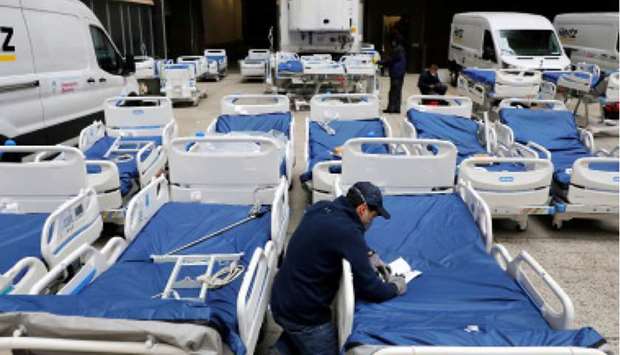The United States aims to build hundreds of temporary hospitals to ease pressure on medical centres struggling to keep up with a surge of coronavirus patients, officials said yesterday, a day after the number of US deaths hit a new daily high.
The US Army Corps of Engineers, which converted a New York convention centre into a 1,000-bed hospital in the space of a week, is searching for hotels, dormitories, convention centres and large open space to build as many as 341 temporary hospitals, the chief of corps said yesterday.
“The scope is immense,” Lieutenant General Todd Semonite of the corps told the ABC News.
“We’re looking right now at around 341 different facilities across all of the United States.”
The US caseload rose by more than 20,000 confirmed cases on Monday, overwhelming hospitals that are running out of doctors, nurses, medical equipment and protective gear.
The corps, the engineering arm of the US Army, joined with New York state officials to convert New York’s Jacob Javits Convention Center into a facility to treat non-coronavirus patients.
The conversion will relieve the pressure on hospitals treating patients with Covid-19, the respiratory ailment caused by the novel coronavirus.
In addition, construction of a 68-bed field hospital began on Sunday in Manhattan’s Central Park.
Provided by the Mount Sinai Health System and non-profit organization Samaritan’s Purse, the makeshift facility is expected to begin accepting patients soon, Mayor Bill de Blasio said.
The converted convention centre is blocks away from the Hudson River pier where the US Navy hospital ship Comfort docked on Monday.
The floating hospital will take up to 1,000 non-coronavirus patients.
Another temporary New York hospital is planned for the USTA Billie Jean King National Tennis Center where the US Open is played.
In Los Angeles, the USNS Mercy, similar to the Comfort, is already treating patients.
Authorities in New Orleans, Los Angeles and Chicago were setting up field hospitals and convention centres in their cities.
In the New York City suburbs, nurses are bracing for a surge of patients.
The medical surgery unit at New York-Presbyterian Hospital’s Hudson Valley branch has 17 coronavirus patients, more than half its capacity, said nurse Emily Muzyka, 25.
Muzyka, who is training nurses on loan from other units, said she was trying to stay calm, but broke down when a relatively healthy, 44-year-old Covid-19 patient declined quickly and required ventilation.
“I had a meltdown and cried to my boyfriend,” she said.
No-visitor policies mean very ill patients may die alone, adding to the emotional toll.
“I’ve held patients’ hands through their final breaths in the past,” Muzyka said. “It’s a lonely death.”
In a tribute to first responders, New York’s landmark Empire State Building yesterday illuminated the top of its tower in red with a pulsating light on its antenna that simulated an emergency siren.
The building’s website said this was an homage to the “heroic Covid-19 emergency workers.”
The temporary hospitals aim to free all of New York City’s 20,000 hospital beds for coronavirus patients, De Blasio said.
New York is still short on doctors and nurses, and De Blasio asked the US military for help.
“We are going to need a lot more military presence. We’re going to need a lot more help from the federal government, including medical personnel from the military, very, very quickly,” De Blasio told NBC.
US health officials are urging Americans to follow stay-at-home orders until the end of April to contain the spread of the virus, which originated in China and has infected about three-quarters of a million people around the world.
The US government’s top infectious disease expert said yesterday there was some evidence that social distancing efforts to slow the spread of coronavirus were having an impact, even though the situation remained very dangerous.
“We’re starting to see glimmers that that is actually having some dampening effect,” Anthony Fauci, director of the National Institute of Allergy and Infectious Diseases, told CNN in an interview.
“But that does not take away from the seriousness...We clearly are seeing cases going up.”
At least 30 of the 50 states have ordered people to stay home, leading economists to predict severe economic contraction.
US House of Representatives Speaker Nancy Pelosi, a Democrat, said lawmakers needed to take up another coronavirus economic relief bill, but Senate Majority Leader Mitch McConnell, a Republican, said Congress should “wait and see” whether another bill was needed.

A worker checks part of a delivery of 64 hospital beds from Hillrom to The Mount Sinai Hospital in Manhattan, New York City.


